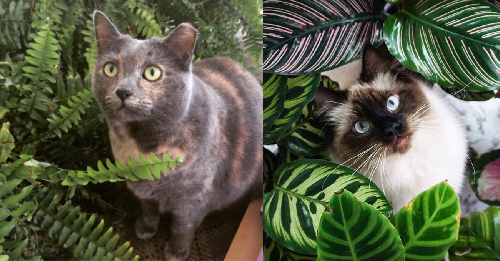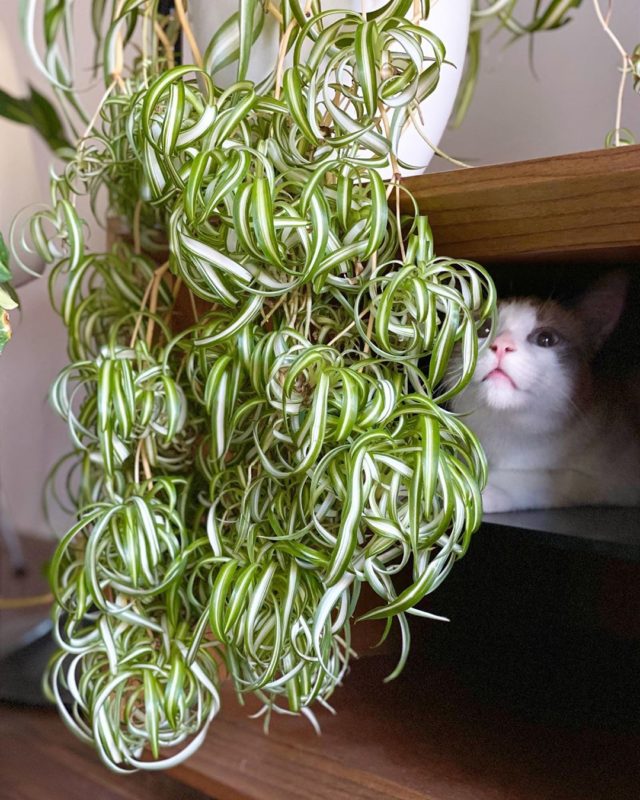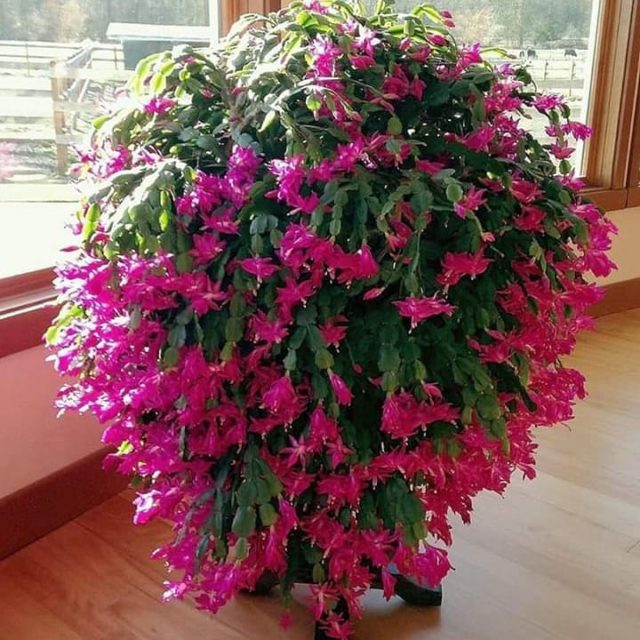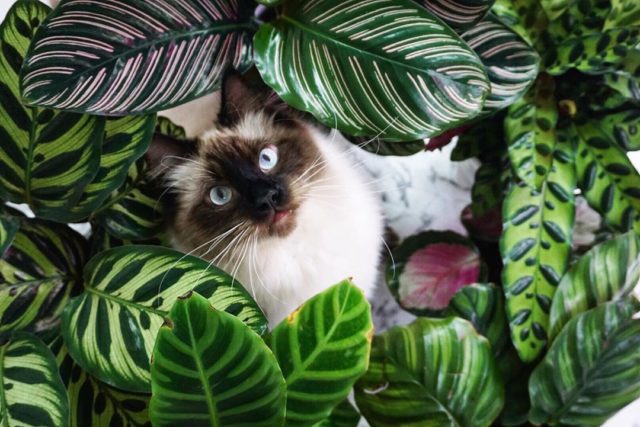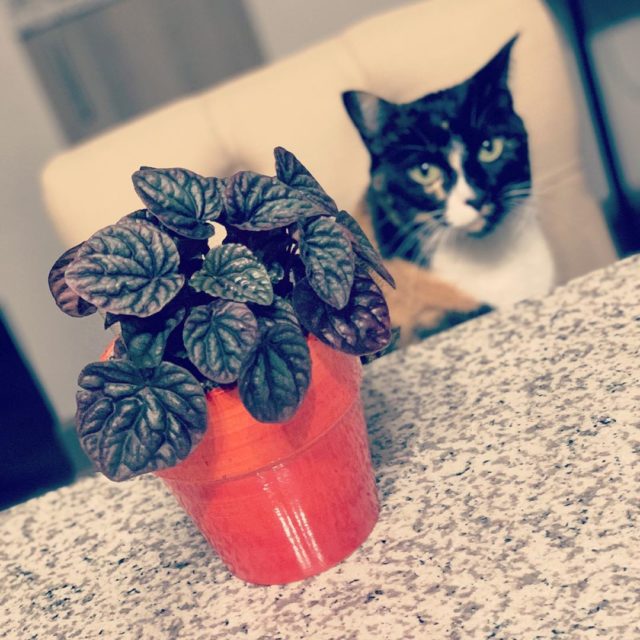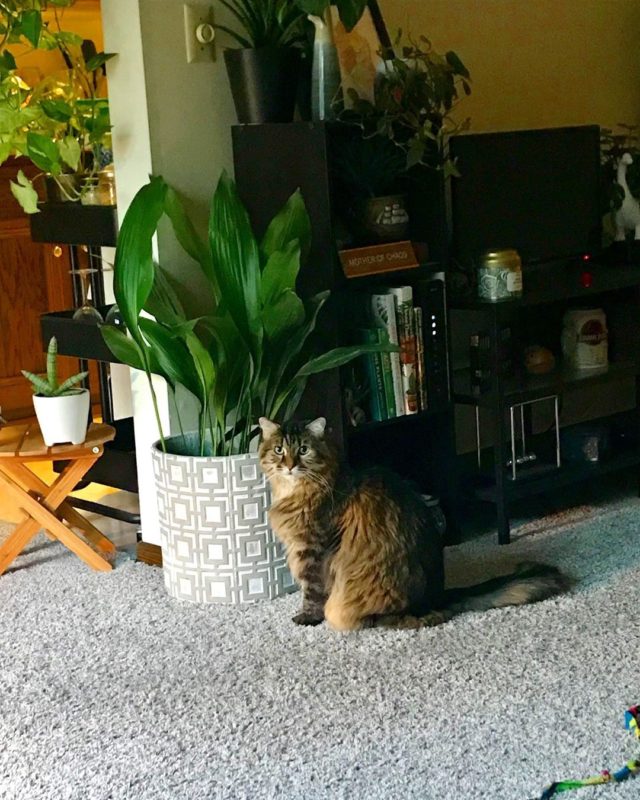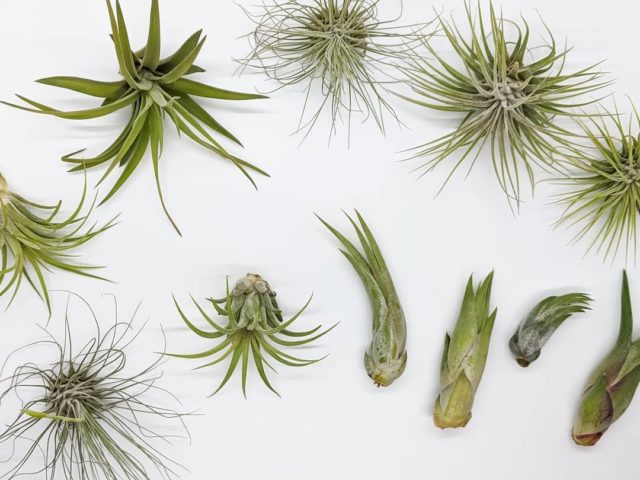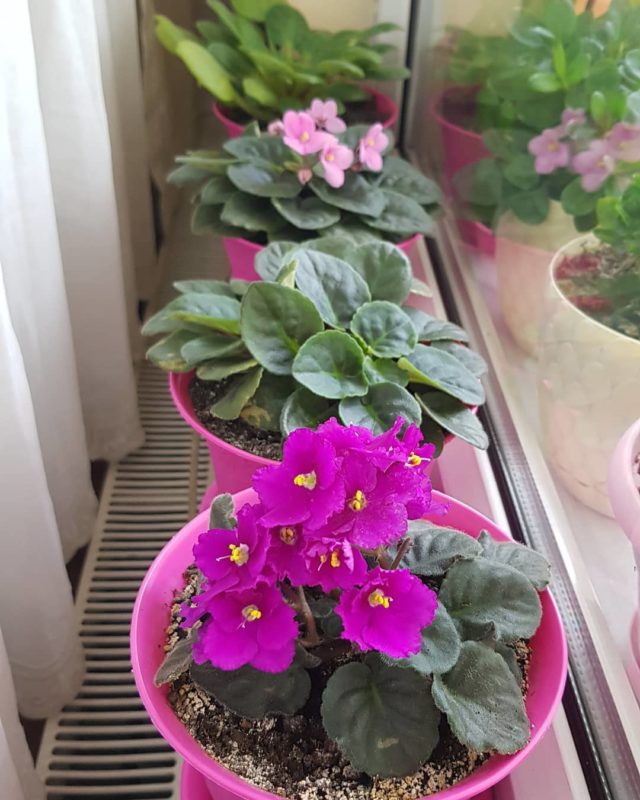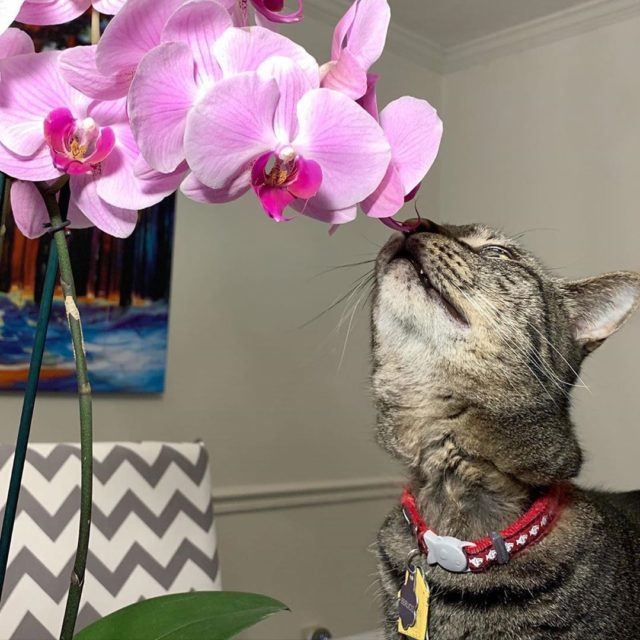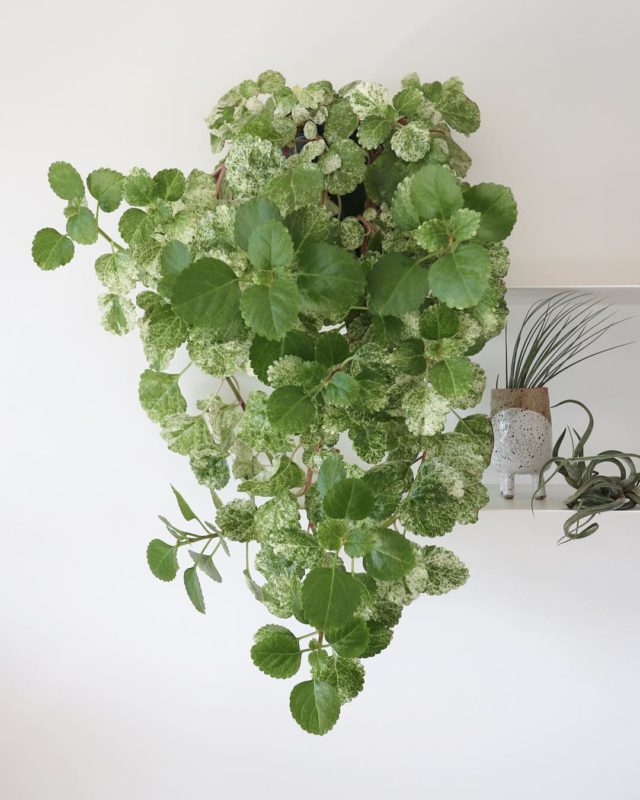Does your kitty love to play jungle cat in your houseplants? If so, you know the importance of giving your furry darling a jungle of plants that are safe for cats. As cat lovers, we know fun for a cat often means touching and tasting, so cat safe houseplants are a must.
This list of 12 cat-safe and 13 cat-toxic plants doesn’t cover the whole of the plant kingdom. But the green lovelies listed here are common household plants proven to thrive indoors and it’s okay if kitty cats stick their whiskered faces in them.
You can find a comprehensive list of toxic and nontoxic plants on the ASPCA website, but in the meantime, fill your place with these cat safe houseplants and enjoy your cat’s reactions to his new jungle.
Cat Safe Houseplants
Parlor palm (Chamaedorea elegans)
Popularized as a household plant in the Victorian era, the Parlor palm is a cat-safe houseplant that grows well under indoor lighting and even reacts to artificial lights. They do enjoy humidity, so don’t let them dry out. Be careful of too much water though. Root rot can set in. Palm care can be a little tricky inside, but well worth it. Kitty will love to play jungle cat beneath this plant. Plus, Parlor palms are proven to purify the air in your home according to a NASA study.
Areca palm (Dypsis lutescens)
Similar to the Parlor palm, the Areca palm prefers bright, but indirect sunlight. But be careful of too much sun as the leaves can burn. The Areca is temperamental about watering, enjoying moist soil in the spring and summer while preferring a drier pot during fall and winter.
The Areca fronds are long and wispy, which easily draws a feline’s attention. Be sure the pot is stable and well-weighted to keep a curious cat from tipping the plant. While these palms are cat safe houseplants, don’t let them destroy it!
Here are a few more palm varieties safe for cats:
- Ponytail palm
- Cat palm
- Majesty Palm
Spider plant (Chlorophytum comosum)
This fringy-fingered plant is often a cat favorite as those dangly babies invite a mischievous cat or kitten to play. But beyond the allure of snagging the spiderettes, spider plants are hallucinogenic to cats. Yes, they get kitties high and too much can be bad for their tummies, causing vomiting and diarrhea. So, while not considered toxic to cats, the spider plant should still be hung or placed high.
If the plant has spilled over the pot’s edge, you may need to do some pruning to keep your cat from claiming it as his own. Beyond keeping the tempting plant from your cat’s clutches, the spider plant requires low maintenance and tolerates low light conditions. And, it’s another of NASA’s clean air plants.
Christmas Cactus (Schlumbergera)
Festive up your house with the strange blooms of the Christmas cactus. An interesting plant with easy propagation tendencies, your cat will enjoy gazing upon the bright flowers. And, if she happens to nip at one of the serrated leaves, don’t fret. The Christmas cactus is considered non-toxic to cats.
With little in the way of needs, the Christmas cactus and its cousins, the Easter cactus and Thanksgiving cactus, require little in the way of light and minimal water. This plant is quite hardy and can live up 20-30 years indoors.
Prayer Plant (Calathea)
With variegated leaves of green, white, or even pink, prayer plants hail from the jungle and love humidity. Calathea can fool you when it comes to water needs though. Finding your plant’s water sweet spot will take a minute, but the work is well worth it as these cat safe houseplants and their wide, glossy leaves are a treat for your eyes and your kitty cat’s.
Radiator Plant (Peperomia)
Plants native to tropical climates, radiator plants love warm air and sunshine. Just like kitty cats. The two play nicely with each other as Peperomia are considered cat safe houseplants. The plant remains small and compact, making it nice for indoor containers. Maybe the small nature of the plant will help keep it from catching kitty dear’s attention. Insert laughter here!
Cast Iron Plant (Aspidistra)
The Cast Iron plant is named aptly. Destruction of the tall, strap-leaved plant is near impossible. Take that, nosy cats!
Stick one of these hardy plants in the darkest corner of your home and forget to water it. The Cast Iron plant doesn’t care. Its drought tolerant and does well for those not good with a watering schedule. This plant is great for houses with savage cats and brown thumbs.
Air plants (Tillandsia)
These funky little plants will blow your mind. Able to grow without soil or water, Tillandsia are considered epiphytes, meaning they grow on other plants or on rocks and bushes. While they don’t require soil for growing, air plants do require a soak in water once a week and love a good misting. Give them indirect, but bright light to keep them happy.
Cats dig these spiky wads of skinny leaves as they are a perfect size for batting around the room. Even though its a cat safe houseplant, smaller ones could make a bite-sized morsel for a curious cat so keep them out of kitty’s grabby reach.
African Violet (Saintpaulia)
With shades of pink, red, lavender, deep indigo, and cream, the African violet is easy to care for, but needs plenty of bright light to maintain its lovely blooms. No direct sun though, the delicate leaves can easily scorch. You’ll want to keep the soil moist and the pot out of reach from kitty paws. Something about African violet blooms attract cats. Perhaps they love the bold colors too and think eating the pretty flower is giving it a high honor. Who knows why felines do the things they do!
Luckily, African violets are another of the cat safe houseplants, but as with anything a cat eats that he or she shouldn’t, keep an eye out for tummy distress.
Moth Orchids (Phalaenopsis Orchids)
If you want a cat safe houseplant with showy blooms, the moth orchid may be the beauty for you. This orchid variety thrives in bright, indirect light and requires water only when the soil is dry to the touch.
Cats think moth orchids are pretty too. Those bright flowers swaying on their stalk can mesmerize a kitty and invite investigation of the tooth and claw kind. Moth orchids can be pricey, so don’t let kitty turn them into toys!
Swedish Ivy (Plectranthus verticillatus)
The Swedish Ivy is a creeping plant that makes long trails of fleshy leaves perfect for a cat to get tangled in. Known also as Creeping Charlie, the Swedish Ivy is not really a member of the ivy family, therefore it’s not toxic to cats like true ivy plants.
The Swedish Ivy grows fast and doesn’t mind letting its soil dry out between watering. Your cat will want to help care for this plant, so good luck convincing kitty dear their aid isn’t necessary!
Certain Types of Ferns (Polypodiopsida)
Putting us in mind of deep forests and fairy gardens, ferns are primordial plants that remind us our wild roots. Maybe cats feel the same among them and that’s okay because there are several varieties of true fern safe for a house with cats. Fans of indirect light and moist soil, try these nontoxic true fern varieties for your house:
- Boston
- Staghorn
- Bird’s nest
- Maidenhair
- Rabbit’s foot
- Button
Houseplants Toxic to Cats
Its imperative cats don’t get hold of the plants mentioned below. This list of plants will cause toxic reactions in cats.
- Asparagus fern
- Cyclamen
- Dumbcane
- Dracaena
- English Ivy
- Fiddle-leaf fig
- Jade plants
- Lilies (highly toxic)
- Peace lily
- Pothos
- Rubber tree (there is a variety known as the American rubber tree which is cat safe, but all other varieties are cat toxic)
- Sago Palm (highly toxic)
- Snake Plants
For information on how to keep your cat safe from toxic plants and foods, check out these valuable guides from the ASPCA Animal Poison Control Center. Keep their number handy in case of a toxicity emergency: (888) 426-4435. Plus, they have an app to make access even quicker.
Also know that while these cat safe houseplants have proven nontoxic to cats, please remember every cat is unique. Like allergies in humans, cats can have adverse reactions to things unexpectedly. So just use care and make sure your cats don’t harm themselves on your plants.
Cats and plants together help create a soothing household, but it’s our responsibility as cat lovers with a green thumb to keep everybody safe!
H/T: www.aspca.com
Feature Image: Six Cats Two Humans/Facebook & @thegardeningqueen/Instagram
